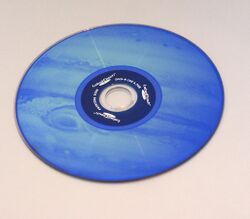Labelflash

Labelflash (sometimes written LabelFlash) is a technology which allows users to burn custom designs or images onto proprietary DVD media first announced in October 2005 as a collaboration between Yamaha and Fujifilm.[1][2] While Yamaha developed the optical drives, Fujifilm manufactured the proprietary Labelflash optical discs.[3] NEC manufactured the first Labelflash compatible drive, the ND4551,[4] which was released in December 2005.[5]
Burning Labelflash media is supported by Nero Burning ROM version 7 and newer.[6] Yamaha partnered with Toshiba[7] and Gateway[8] to provide Labelflash as a feature in computers made by those companies.
Production of Labelflash media was halted on December 22, 2016.[9] Labelflash was officially discontinued in 2017.[10]
Technical details
In Labelflash, the standard recording head of an optical drive is repurposed to burn images onto a layer of dye made for this purpose on the top of proprietary Labelflash optical media.[11] The dye is 0.6mm below the surface so as to protect it from the elements.[10][12]
The resolution is adjustable between 300 and 1800 dpi (dots per inch). Up to 256 monochromatic shades can be used in the image.[4] The labeling process takes 7 minutes at the lowest resolution and a half hour at the highest.[4] Labelflash is backwards compatible with Yamaha's earlier DiscT@2 technology—this allows Labelflash-compatible optical drives to engrave onto the data side of discs as well.
According to Yamaha, a new iteration of Labelflash which supported four color printing was in the works[11]—however, as Labelflash support was discontinued in 2017,[10] this never came to fruition.
Reception
The technology is often compared with Hewlett-Packard's LightScribe, released one year earlier. After its release, Labelflash was not available in the United States until 2007,[12] giving HP a three year head start in the US market. Furthermore, worldwide, proprietary Labelflash optical media costed double that of comparable LightScribe media,[10] at US$2.40 per disc,[13][14] which Tom's Hardware called an "exorbitant" price that made printing "painful" as test prints were not worth doing.[13] Commenting on the price, Engadget's Marc Perton said he'd "stick with [his] Sharpie for now."[15]
Reviewers, such as Gordon Laing for Personal Computer World, also noted that when compared to LightScribe, Labelflash images looked more "unnatural" and less "vibrant".[14]
See also
References
- ↑ Mueller, Scott (2013-03-07) (in en). Upgrading and Repairing PCs: Upgrading and Repairing_c21. Que Publishing. ISBN 9780133105360. https://books.google.com.ph/books?id=gXaRdKyD4PsC&pg=PA602&lpg=PA602&dq=LabelFlash+announcement&source=bl&ots=fMnZ1ERv_3&sig=ssb8n519CCPiZGvm3waLIcb5T4I&hl=en&sa=X&ved=2ahUKEwjR8YT-w8zeAhUJe7wKHZxTAyoQ6AEwDnoECAgQAQ#v=onepage&q=LabelFlash%20announcement&f=false.
- ↑ Peters, Mark (2005-10-24). "FujiFilm and Yamaha LabelFlash Technology". http://www.letsgodigital.org/en/news/articles/story_4912.html.
- ↑ "YAMAHA, FUJIFILM DEVELOP LASER TECHNOLOGY TO ILLUSTRATE DVD." AsiaPulse News, 20 Oct. 2005. General OneFile. Accessed 12 Nov. 2018.
- ↑ 4.0 4.1 4.2 "Integrator Trade Only - Hardware - DVD rewriter - NEC ND4551. Fast DVD rewriter with built-in label writer. Rating: 5 out of 5." Computer Reseller News [UK], 23 Jan. 2006, p. 38. General OneFile. Accessed 12 Nov. 2018.
- ↑ "First Look: Labelflash™ - Myce.com" (in en-US). Myce.com. https://www.myce.com/article/First-Look-Labelflashtrade-235/.
- ↑ 7.0.2.8
- ↑ "First Looks: Bargain Laptop Colossus". PC Magazine: p. 30. 2007-10-02. https://books.google.com.ph/books?id=vLk-j6jSsWkC&pg=PA30.
- ↑ "First Looks Hardware: Junior 3D Gaming Rig". PC Magazine: p. 36. 2008-05-01. https://books.google.com.ph/books?id=s9Dc1sn8wpwC&pg=PA36.
- ↑ "News". Yamaha, Inc. 2016-12-22. http://labelflash.jp/jp/news.html.
- ↑ 10.0 10.1 10.2 10.3 East III, Raymond (2009-07-01). "LightScribe VS. Labelflash: A Disc Labeling Cold War" (in en). https://www.belightsoft.com/products/resources/lightscribe-vs-labelflash.
- ↑ 11.0 11.1 Kubo, Hiroshi; Shibata, Michihiro; et, al (June 2007). "New Laser Labeling Technology for Recordable Digital Versatile Disc". Japanese Journal of Applied Physics 46: 3926–3927. doi:10.1143/JJAP.46.3926. https://www.researchgate.net/publication/239054916_New_Laser_Labeling_Technology_for_Recordable_Digital_Versatile_Disc.
- ↑ 12.0 12.1 "Fujifilm Rolls Out Labelflash DVD Media to U.S. Market" Wireless News, 13 June 2007. General OneFile. Accessed 12 Nov. 2018.
- ↑ 13.0 13.1 Moersch, Siggy (2006-02-14). "Labelflash vs LightScribe DVD/CD Labeling" (in en). Tom's Hardware. https://www.tomshardware.com/reviews/labelflash-lightscribe-dvd,1219.html.
- ↑ 14.0 14.1 Laing, Gordon (2006-05-01). "Add style with flash labels". Personal Computer World: pp. 51, 124. https://archive.org/details/Personal_Computer_World_2006-05_VNU_Business_Publications_GB.
- ↑ Perton, Marc (2006-02-14). "LabelFlash vs. LightScribe: Tom's goes for the burn" (in en-US). Engadget. https://www.engadget.com/2006/02/14/labelflash-vs-lightscribe-toms-goes-for-the-burn/.
External links

